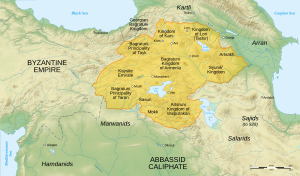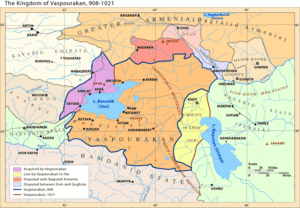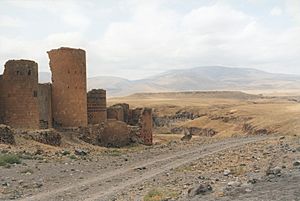Bagratuni dynasty facts for kids
| Bagratuni |
|||
|---|---|---|---|
Quick facts for kids 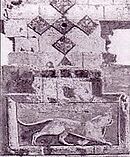 |
|||
| Country: | Armenia | ||
| Parent House: | Orontid dynasty (possibly) | ||
| Titles: | *King of Kings of Armenia and Iberia (Armenian: Շահնշահ Հայոց և Վրաց)
|
||
| Founder: | Smbat I | ||
| Final Ruler: | Gagik II (as King of Armenia) | ||
| Founding Year: | c. 300 AD | ||
| Cadet Branches: | Bagrationis (possibly) Rubenids (possibly) Hasan-Jalalyan (indirectly) Kiurikians |
||
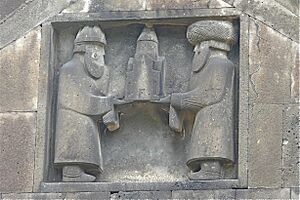
The Bagratuni or Bagratid dynasty was a royal family that ruled the medieval Kingdom of Armenia. They ruled from about 885 AD until 1045 AD.
They started as important helpers to earlier Armenian kings. Over time, they became the most powerful noble family in Armenia. This happened when Arabs ruled the area. Eventually, they created their own independent kingdom. Their kingdom included parts of Armenia like Shirak, Bagrevand, and Syunik. Many historians believe they are also related to the Georgian royal family, the Bagrationi dynasty.
Contents
Who were the Bagratunis?
The name "Bagratuni" comes from an old word meaning "God-given." Historians think the family might have started with a general named Bagadates. He lived around 95-55 BCE during the time of King Tigranes the Great.
The Bagratunis first appeared as nakharars, which were members of Armenia's noble families. This was in the early 4th century. The Arshakuni dynasty, who were earlier kings of Armenia, gave the Bagratunis special rights.
The first known Bagratuni prince, Smbat I, lived when Armenia became Christian around 314 AD. From Smbat's time, the Bagratunis held important titles. They were called aspet, like a "Master of the Horse" for the cavalry. They were also tagadir, which meant they had the special job of crowning new Arshakuni kings.
Their lands included the Sper region, known for its gold and silver. An old Armenian historian, Movses Khorenatsi, claimed they came from Judea. But modern historians think this story was made up to give the family a special origin. Instead, some historians believe the Bagratunis came from the Orontids, an even older ruling family of Armenia.
How did the Bagratunis rise to power?
After the Arabs conquered Armenia in the 7th century, Bagratuni family members often held the title of ishkhan, or "prince" of Armenia. But they still had to report to a Muslim governor. During this time, the Bagratunis became more powerful. The Muslim governors often favored them over other Armenian noble families.
In the mid-8th century, the Bagratuni prince Ashot III joined other Armenian nobles in a revolt against Arab rule. This revolt failed. Later, in 774-775, another Bagratuni leader, Smbat VII Bagratuni, led another rebellion. This one also failed, and Smbat was killed.
After these rebellions, the Bagratunis lost some of their lands. But their losses were not as bad as those of other noble families.
Smbat VII's son, Ashot Msaker, helped the family regain its strength in the 9th century. He fought against local Arab rulers while staying loyal to the main Arab caliphs. Ashot Msaker got back many lands for the Bagratuni family. These lands were divided between his two sons.
One son, Bagrat II, received the lands of Taron and Sasun. He also got a new title, "Prince of Princes." The other son, Smbat "the Confessor," received the title sparapet and lands in Sper and Tayk.
Meanwhile, Ashot Msaker's uncle, Vasak, settled in the Georgian region of Iberia. Vasak's grandson, Ashot I, became the first ruler of Iberia from the Bagratuni family around 813 AD. This part of the family ruled as kings of Georgia for many centuries. They became known as the Bagrationi dynasty.
Bagratuni Kings of Armenia
Ashot I, who was the nephew of Bagrat II, became the first Bagratuni to rule as King of Armenia. The Arab court in Baghdad recognized him as "prince of princes" in 861 AD. This led to wars with local Arab rulers, but Ashot won.
In 885 AD, Baghdad recognized Ashot as King of the Armenians. The Byzantine Empire in Constantinople also recognized him in 886 AD. The Bagratuni kings tried to unite all Armenian lands under their rule. They did this through conquests and by arranging marriages with other noble families.
However, some noble families, like the Artsrunis and Siunis, broke away. They formed their own separate kingdoms, such as Vaspurakan and Syunik.
Ashot III the Merciful moved the capital city to Ani. Ani is now famous for its beautiful ruins. The Bagratuni kings kept their power by balancing the strong Byzantine Empire and the Arab rulers.
They took on the Persian title of "King of Kings" (Shahanshah). But by the 10th century, the Bagratuni family split into different branches. This divided the kingdom when it needed to be united. They faced pressure from new groups like the Seljuks and the Byzantines. The rule of the Ani branch of the family ended in 1045 AD when the Byzantines conquered Ani.
The Kars branch of the family ruled until 1064 AD. A smaller branch, the Kiurikian dynasty, continued to rule as independent kings of Tashir-Dzoraget until 1118 AD. They also ruled Kakheti-Hereti until 1104 AD. After that, they ruled smaller areas around their fortresses until the Mongols conquered Armenia in the 13th century.
The dynasty of Cilician Armenia is also thought to be a branch of the Bagratids. They later became kings of an Armenian Kingdom in Cilicia. The founder, Ruben I, might have been a younger family member or relative of the exiled king Gagik II.
See also
- List of Armenian kings
- Pakradouni



